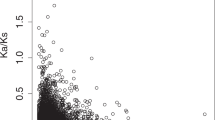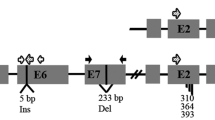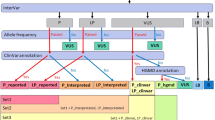Abstract
The recently identified gene for X–linked Kallmann syndrome (hypogonadotropic hypogonadism and anosmia) has a closely related homologue on the Y chromosome. The X and Y copies of this gene are located in a large region of X/Y homology, on Xp22.3 and Yq11.2, respectively. Comparison of the structure of the X–linked Kallmann syndrome gene and its Y homologue shed light on the evolutionary history of this region of the human sex chromosomes. Our data show that the Y homologue is not functional. Comparative analysis of X/Y sequence identity at several loci on Xp22.3 and Yq11.2 suggests that the homology between these two regions is the result of a complex series of events which occurred in the recent evolution of sex chromosomes.
This is a preview of subscription content, access via your institution
Access options
Subscribe to this journal
Receive 12 print issues and online access
$209.00 per year
only $17.42 per issue
Buy this article
- Purchase on Springer Link
- Instant access to full article PDF
Prices may be subject to local taxes which are calculated during checkout
Similar content being viewed by others
References
Kallmann, F., Schoenfeld, W.A. & Barrera, S.E. The genetic aspects of primary eunuchoidism. Am. J. ment. Defic. 48, 203–236 (1944).
De Morsier, G. Etudes sur les dysraphies cranioencephaliques.I Agenesie des lobes olfactifs (telencephaloschizis lateral) et des commissures calleuse et anterieure (telencephaloschizis median). La dysplasie otfacto-genitale. Schweiz. Arch. Neurol. Psychiat. 74, 309–361 (1954).
Schwanzel-Fukuda, M. & Pfaff, D.W. Origin of luteinizing hormone-releasing hormone neurons. Nature 338, 161–163 (1989).
Wray, S., Grant, P. & Gainer, H. Evidence that cells expressing luteinizing hormone releasing hormone mRNA in the mouse are derived from progenitor cells in the olfactory placode. Proc. natn. Acad. Sci. U.S.A. 88, 8132–8136 (1989).
Schwanzel-Fukuda, M., Bick, D. & Pfaff, D.W. Luteinizing hormone-releasing hormone (LH-RH)-expressing cells do not migrate normally in an inherited hypogonadal (Kallmann) Syndrome. Molec. Brain Res. 6, 311–326 (1989).
Franco, B. et al. A gene deleted in Kallmann's syndrome shares homology with neural cell adhesion and axonal pathfinding molecules. Nature 353, 529–536 (1991).
Legouis, R. et al. The candidate gene for the X-linked Kallmann syndrome encodes a protein related to adhesion molecules. Cell 67, 423–435 (1991).
Bick, D. et al. Intragenic deletion of the KALIG-1 gene in Kallmann's syndrome. New Engl. J. Med. 326, 1752–1755 (1992).
Guioli, S. et al. Kallmann syndrome due to a translocation resulting in an X/Y fusion gene. Nature Genet. 1, 337–340 (1992).
Ballabio, A., Bardoni, B., Guioli, S., Basler, E. & Camerino, G. Two families of low-copy number repeats are interspersed in Xp22.3: implications for the high frequency of deletions in this region. Genomics 8, 263–270 (1990).
Petit, C., Levilliers, J. & Weissenbach, J. Long-range restriction map of the terminal part of the short arm of the human X chromosome. Proc. natn. Acad. Sci. U.S.A. 87, 3680–3684 (1990).
Bardoni, B. et al. A deletion map of the human Yq11 region: implications for the evolution of the Y chromosome and tentative mapping of a locus involved in spermatogenesis. Genomics 11, 443–451 (1991).
Yen, P.H. et al. The human X-linked steroid sulphatase gene and a Y-encoded pseudogene: evidence for an inversion of the Y chromosome during primate evolution. Cell 55, 1123–1135 (1988).
Fraser, N., Ballabio, A., Zollo, M., Persico, G. & Craig, I. Identification of incomplete coding sequences for steroid sulphatase on the human Y chromosome: evidence for an ancestral pseudoautosomal gene? Development 101, 127–132 (1987).
Yen, P.H. et al. Cloning and expression of steroid sulfatase cDNA and the frequent occurrence of deletions in STS deficiency: Implication for X-Y interchange. Cell 49, 443–454 (1987).
Shapiro, L.J., Mohandas, T., Weiss, R. & Romeo, G. Non-inactivation of an X chromosome locus in man. Science 204, 1224–1226 (1979).
Keitges, E., Rivest, M., Siniscalco, M. & Gartler, S.M. X-linkage of steroid sulphatase in the mouse is evidence for a functional Y-linked allele. Nature 315, 226–227 (1985).
Yen, P., Ellison, J., Salido, E.C., Mohandas, T. & Shapiro, L.J. Isolation of anew gene from the distal short arm of the human X chromosome that escapes X-inactivation. Hum. molec. Genet. 1, 47–52 (1992).
Rouyer, F. et al. A gradient of sex linkage in the pseudoautosomal region of the human sex chromosomes. Nature 319, 291–295 (1986).
Cooke, H.J., Brown, W.R.A. & Rappold, G.A. Hypervariable telomeric sequences from the human sex chromosomes are pseudoautosomal. Nature 317, 687–697 (1985).
Ellis, N.A. et al. The pseudoautosomal boundary in man is defined by an Alu repeat sequence inserted on the Y chromosome. Nature 337, 81–84 (1989).
Ellis, N.A., Yen, P., Neiswanger, K., Shapiro, L.J. & Goodfellow, P.N. Evolution of the pseudoautosomal boundary in old world monkeys and great apes. Cell 63, 977–986 (1990).
Koenig, M., Camerino, G., Heilig, R. & Mandel, J.L. A DNA fragment from the human X chromosome short arm which detects a partially homologous sequence on the Y chromosome long arm. Nucl. Acids Res. 12, 4097–4109 (1984).
Bickmore, W.A. & Cooke, H.J. Evolution of homologus sequences on the human X and Y chromosomes, outside of the meiotic pairing segment. Nucl. Acids Res. 15, 6261–6271 (1987).
Carle, G.F. & Olson, M.V. Separation of chromosomal DNA molecules from yeast by othogonal-field-alteration gel electrophoresis. Nucl. Acids Res. 12, 5647–5664 (1984).
Sambrook, J., Fritsch, E.F. & Maniatis, T. Molecular Cloning: a Laboratory Manual (Cold Spring Harbor Laboratory Press, New York, 1989).
Pieretti, M., Tonlorenzi, R. & Ballabio, A. Rapid assembly of λ phage contigs within YAC clones. Nucl. Acids Res. 19, 2795 (1991).
Marck, C. DNA Strider: a ‘C’ program for the fast analysis of DNA and protein sequences on the Apple Macintosh family of computers. Nucl. Acids Res. 16, 1829–1836 (1988).
Senapathy, P., Shapiro, M.B. & Harris, N.L. Splice junctions, branch point sites, and exons: sequence statistics, identification, and applications to genome project. Meth. Enzymol. 183, 252–278 (1990).
Yen, P. et al. X/Y translocations resulting from recombination between homologous sequences on Xp and Yq. Proc. natn. Acad. Sci. U.S.A. 88, 8944–8948 (1991).
Author information
Authors and Affiliations
Rights and permissions
About this article
Cite this article
Incerti, B., Guioli, S., Pragliola, A. et al. Kallmann syndrome gene on the X and Y chromosomes: implications for evolutionary divergence of human sex chromosomes. Nat Genet 2, 311–314 (1992). https://doi.org/10.1038/ng1292-311
Received:
Accepted:
Issue Date:
DOI: https://doi.org/10.1038/ng1292-311
This article is cited by
-
Creation of non-human primate neurogenetic disease models by gene targeting and nuclear transfer
Reproductive Biology and Endocrinology (2004)
-
Polymorphic changes in the KAL1 gene: Not all of them should be classified as polymorphisms
Journal of Endocrinological Investigation (2004)
-
A synaptobrevin–like gene in the Xq28 pseudoautosomal region undergoes X inactivation
Nature Genetics (1996)



